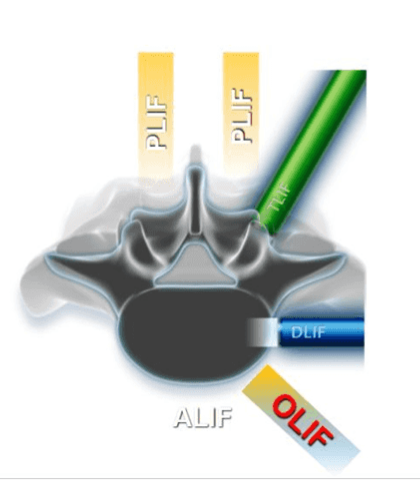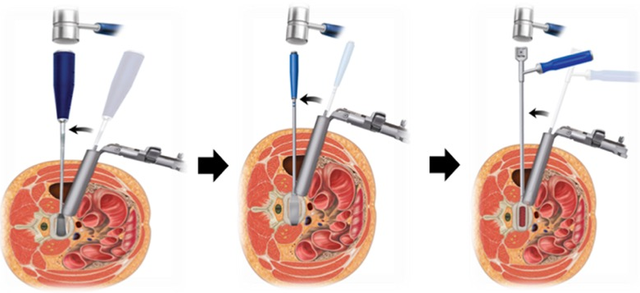What is OLIF Surgery?
OLIF(oblique lateral interbody fusion), is a minimally invasive approach to spinal fusion surgery in which the neurosurgeon accesses and repairs the lower (lumbar) spine from the front and side of the body. It is the very common surgery.
The intervertebral disc is anterior in the entire spinal structure, that is, the oblique anterior approach has great advantages.

●The previous back approach had a long path to go through. It takes skin, fascia, muscle, joints, bone, and then the dura mater to see the disc.
●OLIF surgery is an oblique lateral approach, from the retroperitoneal space to the position of the intervertebral disc, and then a series of operations, such as decompression, fixation, and fusion, are performed.
So compared two different approach, it is easy to know which approach is better,right?
The Advantage of OLIF Surgery
1. The biggest advantage of the oblique lateral approach is that it is minimally invasive surgery, less blood less and Less scar tissue.
2.It does not destroy the normal structure, does not need to cut off some normal skeletal system or muscle system too much, and directly reaches the position of the intervertebral disc from the gap.

3.High fusion rate. Due to the improvement of the instrument, OLIF is more implanted with a large cage. Unlike the posterior approach, due to space constraints, the cage inserted is very small. It is conceivable that to fuse the two vertebral bodies together, the larger the cage inserted, the higher the fusion rate. At present, there are literature reports that theoretically, the fusion rate of OLIF can reach more than 98.3%. For the cage posterior approached, whether the small cage is bullet-shaped or kidney-shaped, the area occupied is probably not more than 25% at most, and the fusion rate achieved is between 85%-91%. Therefore, the fusion rate of OLIF is the highest among all fusion surgeries.
4. Patients have good postoperative experience and less pain. In all the operations, for single-segment fusion, after the fusion under the channel of the posterior approach, the patient will definitely need a few days for pain control and postoperative rehabilitation. It takes about two or three days for the patient to slowly get out of bed and move about. But for OLIF surgery, if you just do Stand-Alone or fixation including posterior pedicle screw, the patient's postoperative experience will be very good. On the second day after the operation, the patient felt little pain and could move on the ground. This is because it goes in completely from the channel, without any damage to any nerve-related level, and there is less pain.
5, OLIF postoperative recovery is fast. Compared with traditional posterior approach surgery, patients after OLIF can recover quickly and return to normal life and work soon.
In Conclusion
To some extent, the indications of OLIF technology basically cover all degenerative diseases of the lumbar spine, such as some inclusive disc herniation, lumbar spinal stenosis, lumbar spondylolisthesis, etc. There are some other aspects that need to be removed, such as spinal tuberculosis and infection that need to be removed in the front.
These diseases can be treated well by OLIF and can achieve better surgical results compared to the original traditional surgery.
XC MEDICO Technical Team are professional for Spinal system Surgery, can provide clinical surgical solutions to our Clients.
Post time: Jun-08-2022
